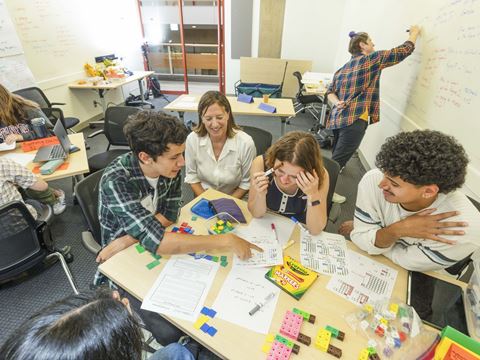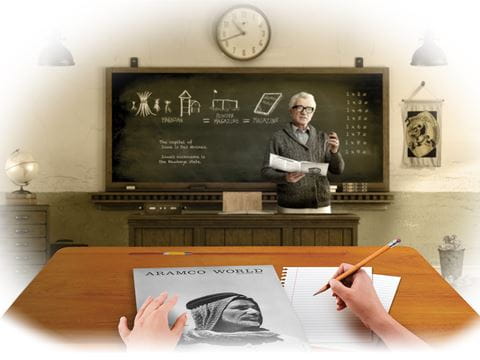
Approaches to Places and People
Subject:
History
Region:
Arab Gulf
Europe
Levant
South Asia
North Africa
How do you approach a place and people whose way of life differs from your own?
For students: We hope this guide sharpens your reading skills and deepens your understanding.
For teachers: We encourage reproduction and adaptation of these ideas, freely and without further permission from AramcoWorld, by teachers at any level.
Common Core Standards met in this lesson: RL/RI.1 (see details below).
—The Editors
Do you have comments? I'd be pleased to hear from you at [email protected].
—Julie Weiss
For teachers: We encourage reproduction and adaptation of these ideas, freely and without further permission from AramcoWorld, by teachers at any level.
Common Core Standards met in this lesson: RL/RI.1 (see details below).
—The Editors
Do you have comments? I'd be pleased to hear from you at [email protected].
—Julie Weiss
"Carsten Niebuhr and the Danish Expedition to Arabia"
How do you approach a place and people whose way of life differs from your own? What attitudes and behaviors do you cultivate? What do you look at if you really want to learn about the people and place? "Carsten Niebuhr and the Danish Expedition to Arabia" chronicles how one small group of 18th-century Europeans answered those questions. Niebuhr led a team on a seven-year journey to exploration to Arabia and Asia. In the article and through the activities, you will learn about Niebuhr's trip, ponder what your own community might look like to an outsider and be able to provide suggestions such an outsider examine in order to understand it. By the time you finish the activities, you will be able to:
- Determine how to approach different cultures and people.
- Identify the goals of Carsten Niebuhr's expedition.
- Decide what a visitor to your community should look for in order to learn the most about it and its residents.
- Assess the value of maps as sources of information about a place.
How Does One Approach Unfamiliar People and Places?
In "Carsten Niebuhr and the Danish Expedition to Arabia," writer Paul Chamberlain says that in the 1700s, when Niebuhr traveled, most Westerners approached "the Orient" judgmentally. What do you think he means by that? When people judge something, they usually apply their own values to others who may potentially hold different values. How do you think being judgmental affects people's understanding of others? Think of an example that supports your answer.
Carsten Niebuhr, however, was not typical of his era. Chamberlain asserts that Niebuhr, in his exploration, insisted on approaching people and places on their own terms. Find evidence in the article to support this assertion. In a class discussion, share the examples you have found. Then answer this question: What do you think led Niebuhr to approach his travels the way he did?
Turn your attention from Niebuhr's attitude to the kinds of information he sought on his trip. There were five goals. Have a volunteer write them on the board or on chart paper. Ask, and answer in a class discussion, why each item was on the list. What was it about diseases and remedies, for example, that was so valuable in the 1760s that explorers would specifically seek out information on the subject?
Now bring this closer to home. Imagine a stranger is visiting your community. Consider each of Niebuhr's five goals, one at a time. Discuss whether or not you would recommend that your visitor have that goal. What value, if any, would there be in exploring the local geography, for example? What could be gained? If, as a class, you don't think a goal would be useful today in your area, explain why you think it wouldn't.
Once you have evaluated the usefulness of Niebuhr's goals in your area, work in a small group to decide what goals you would set for your visitor. For example, would you suggest books to be collected? Or perhaps shows on Netflix or Hulu to be watched, or media posts from locals to be followed? Come up with a list of five or six goals. Write them down, along with a sentence for each, explaining why you think it is important enough to be included on your list. Have groups share their lists and explanations, noting which goals, if any, you have in common. Consider your own list again and revise it if you've learned something from your classmates that you want to include Assign one goal to each small group. Have each group explore and report on what they learn about your community that fits the goal. As a class, evaluate which goals were most useful.
In "Carsten Niebuhr and the Danish Expedition to Arabia," writer Paul Chamberlain says that in the 1700s, when Niebuhr traveled, most Westerners approached "the Orient" judgmentally. What do you think he means by that? When people judge something, they usually apply their own values to others who may potentially hold different values. How do you think being judgmental affects people's understanding of others? Think of an example that supports your answer.
Carsten Niebuhr, however, was not typical of his era. Chamberlain asserts that Niebuhr, in his exploration, insisted on approaching people and places on their own terms. Find evidence in the article to support this assertion. In a class discussion, share the examples you have found. Then answer this question: What do you think led Niebuhr to approach his travels the way he did?
Turn your attention from Niebuhr's attitude to the kinds of information he sought on his trip. There were five goals. Have a volunteer write them on the board or on chart paper. Ask, and answer in a class discussion, why each item was on the list. What was it about diseases and remedies, for example, that was so valuable in the 1760s that explorers would specifically seek out information on the subject?
Now bring this closer to home. Imagine a stranger is visiting your community. Consider each of Niebuhr's five goals, one at a time. Discuss whether or not you would recommend that your visitor have that goal. What value, if any, would there be in exploring the local geography, for example? What could be gained? If, as a class, you don't think a goal would be useful today in your area, explain why you think it wouldn't.
Once you have evaluated the usefulness of Niebuhr's goals in your area, work in a small group to decide what goals you would set for your visitor. For example, would you suggest books to be collected? Or perhaps shows on Netflix or Hulu to be watched, or media posts from locals to be followed? Come up with a list of five or six goals. Write them down, along with a sentence for each, explaining why you think it is important enough to be included on your list. Have groups share their lists and explanations, noting which goals, if any, you have in common. Consider your own list again and revise it if you've learned something from your classmates that you want to include Assign one goal to each small group. Have each group explore and report on what they learn about your community that fits the goal. As a class, evaluate which goals were most useful.
Why Maps?
Niebuhr was a cartographer—someone who makes maps. The article notes that he made maps of every place he visited, maps of both natural features, like coastlines; and human-made features, like Aleppo. Why do you think a cartographer's involvement be essential? What could maps provide? Why would it have been important to get maps of previously unknown places? To answer the question, think about if or when you use maps (and this can include directions you get on a smart phone). Why do you need the maps? Could you function just as well without them? If not, what do you get from a map that you can't get another way? If you were Denmark's King Frederick V, would you have included a cartographer on the trip? Why or why not?
Bonus Map Activity
When you use an online map for directions, or when you look at a map of a city or country, you are getting the view from above. The map shows how a place is organized, as if you were in a airplane looking down at the layout. In the 1760s you might have been able to climb a hill or mountain to get such a view, but that wasn't always possible. How do you think someone makes a map whey they can't get that overview? Try it and see. Choose a neighborhood you don't know well. Walk through it, making a map of the street layout as you go. When you're done, compare the map to an online map of the neighborhood. How close to accurate was your map?
Niebuhr was a cartographer—someone who makes maps. The article notes that he made maps of every place he visited, maps of both natural features, like coastlines; and human-made features, like Aleppo. Why do you think a cartographer's involvement be essential? What could maps provide? Why would it have been important to get maps of previously unknown places? To answer the question, think about if or when you use maps (and this can include directions you get on a smart phone). Why do you need the maps? Could you function just as well without them? If not, what do you get from a map that you can't get another way? If you were Denmark's King Frederick V, would you have included a cartographer on the trip? Why or why not?
Bonus Map Activity
When you use an online map for directions, or when you look at a map of a city or country, you are getting the view from above. The map shows how a place is organized, as if you were in a airplane looking down at the layout. In the 1760s you might have been able to climb a hill or mountain to get such a view, but that wasn't always possible. How do you think someone makes a map whey they can't get that overview? Try it and see. Choose a neighborhood you don't know well. Walk through it, making a map of the street layout as you go. When you're done, compare the map to an online map of the neighborhood. How close to accurate was your map?
Common Core Standards met in this lesson:
RL/RI.1 Read closely to determine what the text says explicitly and to make logical inferences from it; cite specific textual evidence when writing or speaking to support conclusions drawn from the text.
Other lessons

Skate Parks in the Abstract: Analyzing the Alternative World of Abstract Photography
Art
Architecture
Americas
Explore how photographer Amir Zaki’s framed shots alter perceptions of reality.
How To Improve Student Confidence Through Seeing Math Differently
For the Teacher's Desk
Hands-on activities shift math from memorization to exploration—building confidence and curiosity in the classroom.
Teaching Empathy: Five Classroom Activities From AramcoWorld
For the Teacher's Desk
Help students build empathy and community for the academic year with AramcoWorld’s stories and Learning Center lessons.